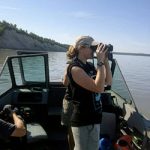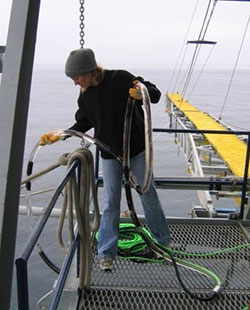Marine Mammalogist
Description
 A marine mammalogist is a scientist who specializes in the study of marine mammals. There are over 100 species of marine mammals including pinnipeds (seals, sea lions, and walrus), cetaceans (whales, dolphins, and porpoises), sirenians (manatees and dugongs), and some carnivores, such as sea otters and polar bears. Marine mammalogy is a diverse field that often includes the study of animal behavior, communication, evolution, physiology, ecology, and zoology. Marine mammalogists may study the genetics, evolutionary relationships, population structure, community dynamics, anatomy and physiology, behavior and sensory abilities, parasites and disease, geographic distributions, ecological interactions, management and/or conservation of marine mammal species. Like zoologists, many work to increase the knowledge and understanding of wildlife species. They often conduct field research to learn about the behavior and interactions of marine mammals in their natural environment.
A marine mammalogist is a scientist who specializes in the study of marine mammals. There are over 100 species of marine mammals including pinnipeds (seals, sea lions, and walrus), cetaceans (whales, dolphins, and porpoises), sirenians (manatees and dugongs), and some carnivores, such as sea otters and polar bears. Marine mammalogy is a diverse field that often includes the study of animal behavior, communication, evolution, physiology, ecology, and zoology. Marine mammalogists may study the genetics, evolutionary relationships, population structure, community dynamics, anatomy and physiology, behavior and sensory abilities, parasites and disease, geographic distributions, ecological interactions, management and/or conservation of marine mammal species. Like zoologists, many work to increase the knowledge and understanding of wildlife species. They often conduct field research to learn about the behavior and interactions of marine mammals in their natural environment.
Marine mammalogists may specialize in the study of particular groups of species. For example, because there are such large differences between taxa, they may specialize in the study of pinnipeds, or odontocetes, or mysticetes. Alternatively, some scientists specialize in the study of animals that may share a common environment, such as Arctic species.
Education Requirements
Estimated Salary
- B.S. in biology, chemistry, physics, ecology, geology, psychology, or related science field(undergraduate degree need not be in marine biology)
- A minor in any science, computer science, mathematics, statistics, or engineering may be helpful. It is also important to gain practical experience and field work exposure, if possible, within the field of marine mammalogy (e.g. volunteering and/or interning at an aquarium or zoo, being a lab assistant or volunteering in any federal, state or local organization that works with marine mammals)
- Master’s degree in marine sciences, marine biology, zoology, statistics or psychology is often needed for advancement
- A PhD is necessary for most independent research and college teaching positions
- SCUBA certification and at-sea or boat handling experience may be desirable but not required
For salary information, please visit the United States Bureau of Labor Statistics
Tasks and Duties
A marine mammalogist may have a variety of responsibilities depending on the specific nature of their job. These could include:
- Designing and conducting research (in laboratory or field-based settings)
- Tracking and monitoring marine mammals to investigate habitat, interactions, predator-prey relationships, reproduction, foraging, and/or migration behaviors, fisheries interactions, etc.
- Researching how human-caused activities, including anthropogenic sound, may effect marine mammals
- Collecting and evaluating data
- Writing papers, reports, scholarly articles, and/or grant proposals
- Attending seminars, conferences, and other events
- Giving lectures and presenting findings to other industry professionals
- Providing conservation awareness
- Making policy, conservation, and management recommendations
- Teaching undergraduate and graduate courses (if in academia)
Knowledge and Skills
Basic skills might include:
- Field observation and sampling
- Fieldwork can be physically demanding
- Field research settings can range from tropical habitats to locations in extreme environments such as far offshore or polar areas
- Specimen collection and preservation
- Computer skills
- Geographic Information Systems (GIS)
- Global Positioning Systems (GPS)
- Computer modeling; Mathematical modeling
- Interpersonal Skills
- Networking with other scientists, biologists, and industry members (cooperation/collaboration)
- Ability to teach and mentor undergraduate and graduate students (university-level teaching positions)
- Coordination and supervision of research personnel
- Open water diving skills and the necessary certifications may be required for some positions
- Because marine mammals are found worldwide, the ability to speak in a foreign language may also be helpful, especially if work is conducted in other countries.
May need knowledge in:
- Acoustics
- Animal Behavior
- Animal Communication
- Animal Physiology
- Biology; Molecular Biology
- Chemistry/Biochemistry
- Computer science (geographic information systems [GIS], modeling programs)
- Environmental Science
- Evolutionary Biology
- Genetics
- Marine Biology
- Marine Conservation
- Marine Ecology
- Mathematics
- Physics
- Statistics; Biometrics
- Taxonomy and Systematics
- Zoology
Connections to Underwater Acoustics
Bioacoustics is an interdisciplinary science focusing on sound production and reception in animals, how sounds are used by different species, and how sound can be used to detect and localize animals. This field of study can include researching how animals produce sound; how ears sense sounds; and the role that sound plays in communication between individuals. Studies may also focus on the impact of anthropogenicsound on marine mammals, what sounds may cause injury or tissue damage, and the ways in which sounds may disrupt a species’ normal activities.
Each marine mammal species produces distinctive sound such as echolocation clicks, calls, or songs. Sounds may be used for communication, feeding, and/or navigation . Marine mammalogists can listen to and study marine mammal sounds, identify species, estimate abundance, document distribution and make potential correlations to behavior, all of which provide valuable information to resource managers overseeing natural resource policies on the marine environment.
Marine mammal bioacoustics work includes the use of underwater acoustic tools such as hydrophones, hydrophone arrays, and other passive acoustics sensors to detect and monitor the presence of marine animals, the sounds they make, and the potential effects of anthropogenic noise. Hydrophone arrays can be used to detect and calculate the position of a marine mammal producing sound. A hydrophone array consists of three or more hydrophones deployed at different locations. Researchers also use archival passive listening systems also called Marine Autonomous Recording Units (ARUs) , or “pop-up” buoys, which record underwater sound and can be used to evaluate the presence of marine mammals in an area. Passive acoustic recording tags help overcome many of the limitations experienced with visual surveys. They have been incorporated into survey methods to improve animal abundance estimates, especially for cetacean surveys. Passive acoustic recording tags, such as the “D-tag”, developed by the Woods Hole Oceanographic Institution, have allowed scientists to measure the acoustic environment in tandem with behavioral information for the tagged animal. The tag records not only the sounds of a tagged whale, but all other sounds from various sound sources in the area such as boats (even distant ships) and other whales. D-tags have been used to study many marine mammals such as humpback whales , North Atlantic Right Whales , sperm whales , pilot whales , blue whales , gray whales, , Blainville’s beaked whales and Cuvier’s beaked whales, as well as fur seals.
Example of someone in this career
Elizabeth Henderson
 Elizabeth Henderson has been conducting behavioral and acoustic studies of marine mammals for over 15 years. She has worked primarily in the field with wild populations of a variety of cetacean and pinniped species, but has conducted lab-based research with captive animals as well. Her primary interests are behavioral ecology, bioacoustics, and the impact of noise on the behavior and habitat use patterns of marine mammals. She received her Master’s degree from Texas A&M University, and her PhD from Scripps Institution of Oceanography at UCSD. She currently works with the National Marine Mammal Foundation as a Marine Bioacoustic Specialist, where she conducts research on the impact of anthropogenic noise on marine mammals and applies this knowledge to environmental compliance documents for the U.S. Navy.
Elizabeth Henderson has been conducting behavioral and acoustic studies of marine mammals for over 15 years. She has worked primarily in the field with wild populations of a variety of cetacean and pinniped species, but has conducted lab-based research with captive animals as well. Her primary interests are behavioral ecology, bioacoustics, and the impact of noise on the behavior and habitat use patterns of marine mammals. She received her Master’s degree from Texas A&M University, and her PhD from Scripps Institution of Oceanography at UCSD. She currently works with the National Marine Mammal Foundation as a Marine Bioacoustic Specialist, where she conducts research on the impact of anthropogenic noise on marine mammals and applies this knowledge to environmental compliance documents for the U.S. Navy.
Related Careers
- Animal/Marine Mammal Trainer
- Behavioral Biologist
- Biological Oceanographer
- conservation Biologist
- Environmental Scientist
- Evolutionary Biologist
- Fisheries Observer
- Marine Biologist
- Marine Ecologist
- Marine Educator
- Marine Resource Manager
- Marine Veterinarian
- Museum Curator
- Naturalist
- Research Technician
- Wildlife Biologist
- Zoologist
DOSITS Links
Animals and Sound
- Use of Sound > Marine mammal communication
- Use of Sound > Marine mammal feeding
- Use of Sound > Marine mammal navigation
- Sound Production > How do marine mammal produce sound?
- Sound Reception > How do marine mammals hear?
- Effects of Sound > Determine if a sound affects a marine mammal
- Effects of Sound > Potential effects of sound on marine mammals
- Effects of Sound > Measure marine mammal’s reaction to sound
People and Sound
- Investigate Marine Mammals> How is sound used to study marine mammal distribution?
- Investigate Marine Mammals> How is sound used to estimate marine mammal abundance?
- Investigate Marine Mammals> How is sound used to protect marine mammals?
Technology Gallery
- Observing and Monitoring Marine Animals> Archival Marine Acoustic Recording Units (ARUs)
- Observing and Monitoring Marine Animals> Real-time Passive Acoustic Sensors
- Observing and Monitoring Marine Animals> Passive Acoustic Recording Tags
- Observing and Monitoring Marine Animals> Acoustic Gliders
Resources
- Sea Grant Marine Careers: Marine Biology
- Sea Grant Marine Careers, profile: Shannon Atkinson
- NOAA OceanAGE, career profile: Kristin Laidre
- NOAA Fisheries Service: Careers in Marine Life
- The Society for Marine Mammalogy, How to Become a Marine Mammal Scientist
- The Institute for Marine Mammal Studies: Strategies for pursuing a career in marine mammal science
- United States Bureau of Labor Statistics
- Strategies for pursuing a career in marine mammal science